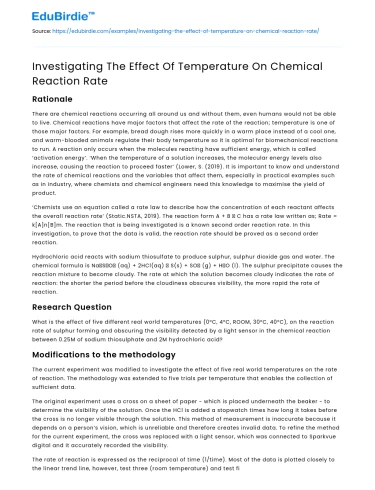Rationale
There are chemical reactions occurring all around us and without them, even humans would not be able to live. Chemical reactions have major factors that affect the rate of the reaction; temperature is one of those major factors. For example, bread dough rises more quickly in a warm place instead of a cool one, and warm-blooded animals regulate their body temperature so it is optimal for biomechanical reactions to run. A reaction only occurs when the molecules reacting have sufficient energy, which is called ‘activation energy’. ‘When the temperature of a solution increases, the molecular energy levels also increase, causing the reaction to proceed faster’ (Lower, S. (2019). It is important to know and understand the rate of chemical reactions and the variables that affect them, especially in practical examples such as in industry, where chemists and chemical engineers need this knowledge to maximise the yield of product.
‘Chemists use an equation called a rate law to describe how the concentration of each reactant affects the overall reaction rate’ (Static.NSTA, 2019). The reaction form A + B → C has a rate law written as; Rate = k[A]n[B]m. The reaction that is being investigated is a known second order reaction rate. In this investigation, to prove that the data is valid, the reaction rate should be proved as a second order reaction.
Save your time!
We can take care of your essay
- Proper editing and formatting
- Free revision, title page, and bibliography
- Flexible prices and money-back guarantee
Hydrochloric acid reacts with sodium thiosulfate to produce sulphur, sulphur dioxide gas and water. The chemical formula is Na₂S₂O₃ (aq) + 2HCl(aq) → S(s) + SO₂ (g) + H₂O (l). The sulphur precipitate causes the reaction mixture to become cloudy. The rate at which the solution becomes cloudy indicates the rate of reaction: the shorter the period before the cloudiness obscures visibility, the more rapid the rate of reaction.
Research Question
What is the effect of five different real world temperatures (0°C, 4°C, ROOM, 30°C, 40°C), on the reaction rate of sulphur forming and obscuring the visibility detected by a light sensor in the chemical reaction between 0.25M of sodium thiosulphate and 2M hydrochloric acid?
Modifications to the methodology
The current experiment was modified to investigate the effect of five real world temperatures on the rate of reaction. The methodology was extended to five trials per temperature that enables the collection of sufficient data.
The original experiment uses a cross on a sheet of paper - which is placed underneath the beaker - to determine the visibility of the solution. Once the HCl is added a stopwatch times how long it takes before the cross is no longer visible through the solution. This method of measurement is inaccurate because it depends on a person’s vision, which is unreliable and therefore creates invalid data. To refine the method for the current experiment, the cross was replaced with a light sensor, which was connected to Sparkvue digital and it accurately recorded the visibility.
The rate of reaction is expressed as the reciprocal of time (1/time). Most of the data is plotted closely to the linear trend line, however, test three (room temperature) and test five (40°C) are both not as close to the line as the three other tests. This shows that those tests vary further from the line of best fit. The r^squared value is correlation determination. This means that approximately 98% of the total variation for the reciprocal of time can be explained by the linear relationship between the temperature. The remaining 2% is probably because of test three and five and its variation is the unexplained but most likely do to the errors and limitations in the experiment. For the data to be second order, the ‘rate must be proportional to the square of the concentration of the reactant’ (Brown. D, 2019). The graph shows a strong positive correlation that therefore means the data is reliable. The r^squared value of 0.976 is close to 1. This proves that the relationship between the rate of reaction and temperature is proportional to the square of the concentration of the reactant, and therefore is evidence of a second order reaction.
Conclusion
The results show that there is a definite relationship between the effects of temperatures on the reaction rate of this investigation. The data collected is reliable as it shows definite trends and relationships that can be reproduced, as the error bars of absolute uncertainty and percentage uncertainty are small. Graphs 1 and 2 both are both relatively straight. To determine the reaction order as a second order reaction, graph 1 needed to show a curved line. Instead, the line was straight, which showed evidence of a first order reaction. Because the graphs showed evidence of both first and second order reactions, as can be seen in Images 1 and 2, it is a sign that the data is invalid and there could be no conclusions made as to which order it is. Overall, the investigation proves through calculations, trends and relationships, that as temperature increases the rate of reaction decreases, and it is therefore inversely proportional.
References
- Lower, S. (2019). Changing Reaction Rates with Temperature. Retrieved 22 August 2019, from https://chem.libretexts.org/Bookshelves/Physical_and_Theoretical_Chemistry_Textbook_Maps/Supplemental_Modules_(Physical_and_Theoretical_Chemistry)/Kinetics/Modeling_Reaction_Kinetics/Temperature_Dependence_of_Reaction_Rates/Changing_Reaction_Rates_with_Temperature
- Brown, D. (2019). Meaning definition of rate of reaction slow fast apparatus experiments for measuring reaction rates laboratory coursework lab assignment help ideas gcse chemistry revision notes science KS4 igcse. Retrieved 5 September 2019, from http://www.docbrown.info/page03/3_31rates1.htm
- CLEAPSS. (2018). Student safety sheets 35 Sodium sulfites, thiosulfate & persulfate including metabisulfite & potassium salt. Retrieved 5 September 2019, from http://science.cleapss.org.uk/Resource/SSS035-Sodium-sulfites-thiosulfate-and-persulfate.pdf
- Scientific, F. (2017). Rate of Reaction of Sodium Thiosulfate and Hydrochloric Acid. Retrieved 5 September 2019, from https://www.flinnsci.com/api/library/Download/78da6c8204aa48a294bd9a51844543ad
- Static.NSTA. (2019). Lab 29. Rate Laws: What Is the Rate Law for the Reaction Between Hydrochloric Acid and Sodium Thiosulfate. Retrieved 6 September 2019, from http://static.nsta.org/extras/adi-chem/Lab29StudentHandout-RateLaws.pdf






 Stuck on your essay?
Stuck on your essay?

